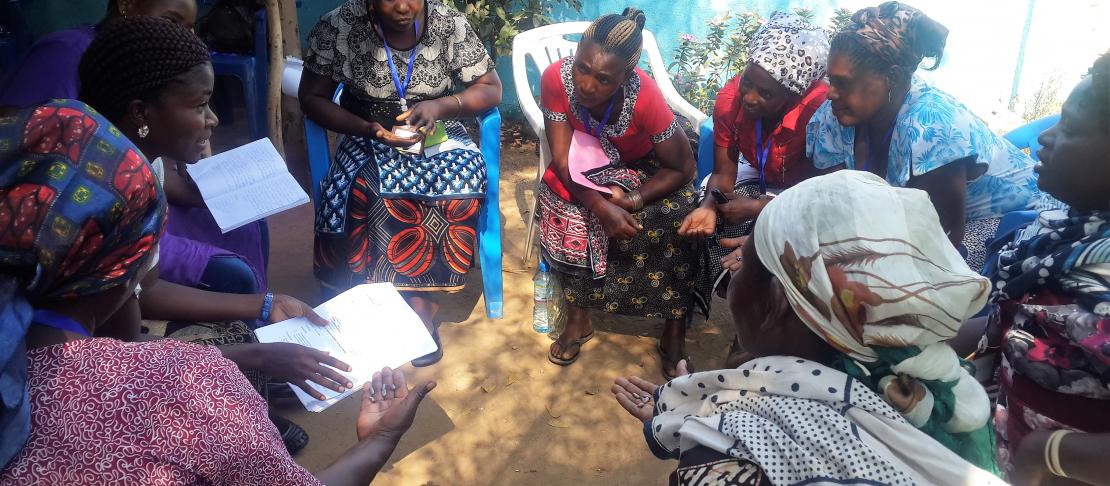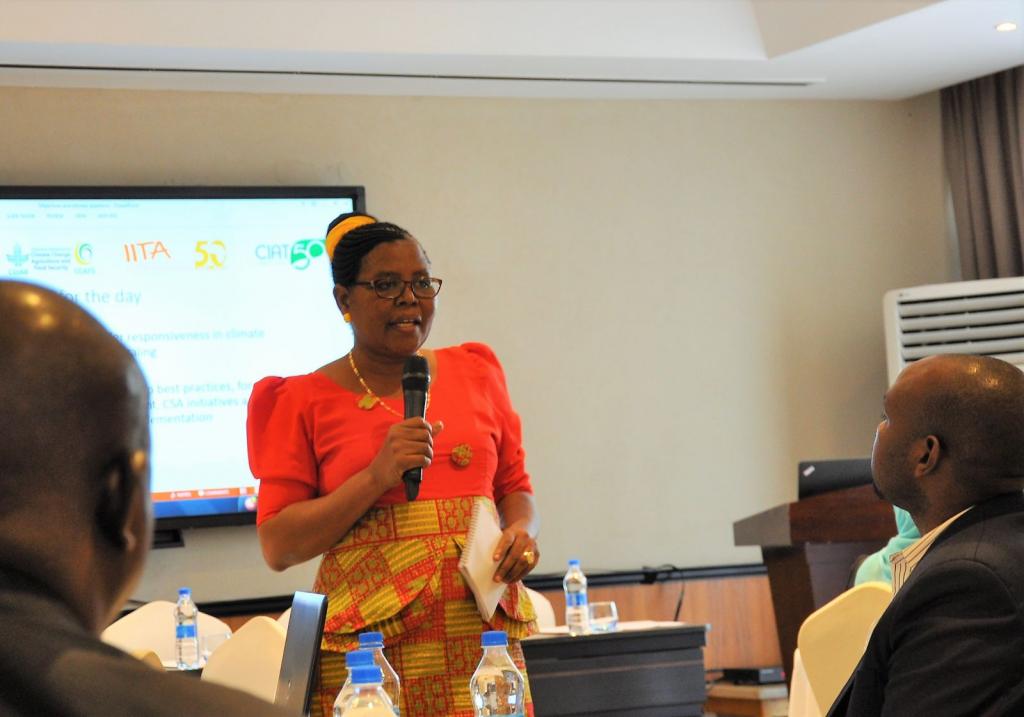Lessons for successful scaling of climate-smart agriculture innovations

Two concluding projects offer lessons for successful implementation of climate-smart agriculture innovations at wider scales.
Evidence generated from two aligned climate-smart agriculture (CSA) scaling projects was recently presented to attendees at project wrap-up meetings in Tanzania and Uganda. The attendees included parliamentarians, development partners, government technical experts, scientists, representatives from non-governmental institutions, and farmer representatives. The evidence was given through testimonies, PowerPoint presentations, panel and plenary discussions, as well as short documentaries. The workshops were organized on 27 October (Tanzania) and 30 October (Uganda) by the International Institute of Tropical Agriculture (IITA), International Center for Tropical Agriculture (CIAT), and partners to share lessons and inform future climate adaptation, CSA planning, implementation and scaling.
The four-year projects, which both started in 2014 and will conclude at the end of 2017, were implemented under the CGIAR Research Program on Climate Change, Agriculture and Food Security (CCAFS). In Uganda, the projects were carried out with the Climate Change Department under the Ministry of Water and Environment (MWE) and in Tanzania by the Environment Management Unit (EMU) under the Ministry of Agriculture, Livestock and Fisheries (MALF).
Project 1: Policy action for climate change adaptation (PACCA)
The IITA-led PACCA project was funded by CCAFS and aimed to use interdisciplinary science-based recommendations to influence and link policies and institutions from national to local level for the development and adoption of climate resilient food systems in East Africa. Policy and policy actor analysis was used in the beginning to map the status of the adaptation policies and the coordination of policy actors so as to identify entry-points for improvement.
The project also conducted research on organizational networks to understand drivers of climate smart technology (CST) uptake to guide choices for CST development and adoption. Trade-off analyses of locally appropriate CSA practices across scales were used to inform investment decisions. The project also created evidence-based gender awareness among policy actors, with the intent to influence gender responsive implementation of climate change adaptation policies. By remaining engaged with policymakers throughout the research process, the researchers were able to work together toward implementation of jointly proposed policy engagement strategies.
Using the concept of a “learning alliance”, the project to enhance members’ capacity to develop and implement more climate-resilient and gender-sensitive policies by creating a space for knowledge-sharing, training on adaptation planning tools, and distributing the latest climate smart agriculture research. Speaking on behalf of the Commissioner for the Climate Change Department at the Uganda event, Mr. Bob Natifu highlighted the contribution of the national climate change learning alliance in improving the understanding of climate change impacts, thus enabling public institutions, individuals and non-state actors to tap into the opportunities and co-benefits arising from mitigation and adaptation actions.
The learning alliance model is being adapted by the climate change department, which is the climate change focal point in the country, to implement the capacity building component of the UNFCCC.
Project 2: Food security and farming system resilience
The CIAT-led project on Increasing food security and farming system resilience in East Africa through wide-scale adoption of climate smart agriculture practices was funded by the International Fund for Agriculture Development (IFAD) and aimed to improve food security and farming systems resilience of smallholder mixed crop-livestock farmers in East Africa while mitigating climate change. The project, whose strength was in combining participatory and systematic approaches, according to the Coordinator Caroline Mwongera, built on the effectiveness of CSA by generating a scientific basis for strategic targeting of locally appropriate practices.
A desktop assessment of CSA practices was done to clarify their potential impacts on food production, resilience of farming systems and greenhouse gas balance. Additionally, spatially explicit monitoring and modelling of land health and organic suitability as well as multi-dimensional trade-off analysis was conducted to identify locally appropriate CSA technologies. Biophysical field surveys and gender disaggregated socio-economic surveys were done to assess socio-economic processes in landscapes to better understand opportunities for CSA scaling. Assessment of land and soil health was carried out using the Land Degradation Surveillance Framework (LDSF) to quantify soil organic carbon content, crop diversity, management practices, and measure land degradation and effectiveness of rehabilitation measures over time.
The most promising CSA practices were implemented and appraised at local level to identify perceived benefits and barriers of adoption. Using demonstration plots managed by farmers and demonstration trainings with local partners such as ZOA (an international relief and recovery organization) in Northern Uganda, and the African Conservation Tillage Network (ACTN) in Tanzania, as well as smart monitoring combining ICT tools with the "5Q" approach, knowledge on CSA was increased among smallholder farming communities which led to greater adoption of locally appropriate CSA technologies for improved food security. Through strategic policy and development partnerships, CSA activities were up-scaled and out-scaled in East Africa. The learning alliance approach, promoted by the PACCA project, was used for sharing knowledge, tools, approaches and policies for wide-scale adoption of CSA technologies.
Project impacts
The projects were able to make significant contributions to the ways in which both countries are addressing agricultural adaptation to climate change. By working directly with decision makers, the researchers were able to share knowledge, change attitudes, and enhance people’s capacities.
Mr. Natifu noted that “the CSA scaling projects have enabled the piloting of the Uganda CSA program, jointly implemented by Ministry of Agriculture, Animal Industry and Fisheries and Ministry of Water and Environment.”
“It is only through these learning alliances that we can upscale practices,” Ms. Natai Shakwaanande, the Head of Environment Management Unit Ministry of Agriculture, Livestock and Fisheries (MALF), said during the wrap up event in Tanzania. “We are trying to see how to merge the Tanzania CSA Taskforce with the learning alliance to create the Tanzania CSA Alliance.”

Ms. Natai Shakwaanande, Head of the Environment Management Unit of the Ministry of Agricultural, Livestock and Fisheries in Tanzania, speaks at the workshop. Photo: JF Okiror
Some local-level learning alliances have successfully attracted climate change funding from the district budgets. “We convinced the councilors to pass a budget of TZS 10 million for climate change issues and for the Chairperson to participate in learning alliance meetings,” said Moses Eliezer, the Lushoto learning alliance facilitator. “We disseminated climate change information to the grassroots level, selecting four people as ambassadors in village assemblies and documented success stories in pilot villages.”
The learning alliances have bridged coordination gaps across sectors and between central and local governments, making policy formulation more “bottom up” by involving district level policy implementers and local community in national policy formulation. They provide coordinated climate change engagement and improve skills for adaptation planning, which promotes the creation of climate change policies that are resilient and gender-responsive.
Gathering lessons to share with future projects
Smallholder farming systems in East Africa are a complex matrix of land cover typologies, socio-economic realities, and governance structures. The projects that are winding down offer the following lessons to better target adaptive and resilient farming systems and are important for successful scaling of CSA innovations. (Links in each lesson will open a brief with more detailed information.)
- Formulate equitable climate-smart agriculture policies
- Design climate smart agricultural interventions to be gender inclusive
- Assess whole-farm trade-offs and synergies
- Support farmer-to-farmer and community wide social learning
- Know what drives the adoption of climate smart agriculture across different scales
- Target pathways to scale out climate smart agriculture technologies to farming communities
- Prioritize among climate-smart agriculture options and benefits for greater impacts
- Invest in climate smart soil and land health
- Monitor climate smart agriculture interventions with a real time participatory tool
These lessons have the potential for global application and have been used to scale out successful practices to a wider set of stakeholders. In Uganda, they informed the design of the Project for the Restoration of Livelihoods in the Northern Region (PRELNOR), a US$70 million project funded by the Government of Uganda and IFAD. The aim is to share the lessons more broadly and help inform successful CSA targeting and scaling to enhance climate resilience.
Do these lessons resonate with you? What are some lessons you might have learned that are not included in this list? Use the comment box below to share your thoughts with us.
Read more:
John Francis Okiror is a communications specialist at IITA, and Laura Cramer is Science Officer for the Flagship on Priorities and Policies for Climate Smart Agriculture.
Interested in more updates like this? Subscribe to the Priorities and Policies for CSA quarterly newsletter by clicking here.



